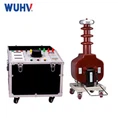An AC (alternating current) resonant test system is a type of electrical testing system used to assess the insulation integrity and quality of high-voltage electrical equipment, such as transformers, cables, and circuit breakers. The test involves applying a resonant AC voltage to the equipment under test and monitoring its response.
Here are the key components and principles of an AC resonant test system:
Power Supply: The system typically includes a high-voltage AC power supply capable of generating the required test voltage. The voltage is often sinusoidal and can be adjusted to match the rated voltage of the equipment being tested.
Resonant Circuit: The resonant circuit consists of an inductor (coil) and a capacitor connected in parallel. This circuit is tuned to the frequency of the applied test voltage. The resonance condition enhances the efficiency of the test and allows for high currents at the resonant frequency.
Coupling Transformer: The test voltage generated by the power supply is fed into the equipment under test through a coupling transformer. The transformer is used to match the impedance between the power supply and the equipment.
Measurement and Monitoring Equipment: Various instruments are employed to measure and monitor parameters during the test, such as voltage, current, power factor, and resonance frequency. These measurements help assess the condition of the insulation and detect any abnormalities.
Control System: A control system is used to regulate the test parameters, including voltage levels, frequencies, and duration. It ensures that the test is conducted within specified limits and safety standards.
The AC resonant test is particularly useful for detecting insulation defects, such as partial discharges, corona, and other weaknesses that might compromise the reliability and safety of the electrical equipment. The resonant frequency is chosen to maximize the energy transfer to the test object, making it a sensitive method for identifying potential issues.
It's worth noting that AC resonant testing is just one method among several high-voltage testing techniques, and the choice of method depends on the specific requirements of the equipment being tested and the standards to which it must adhere.




